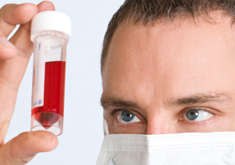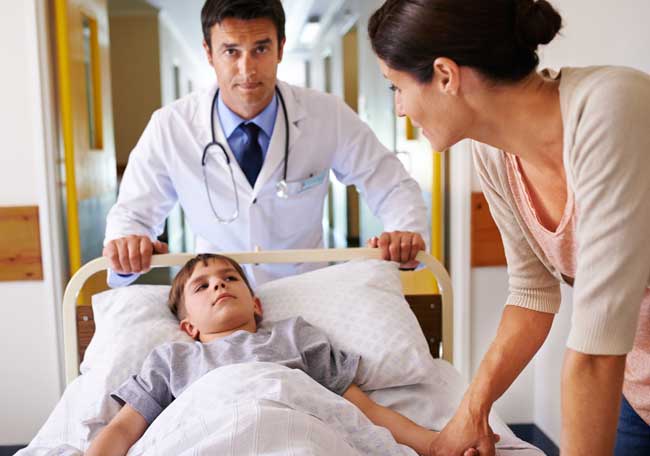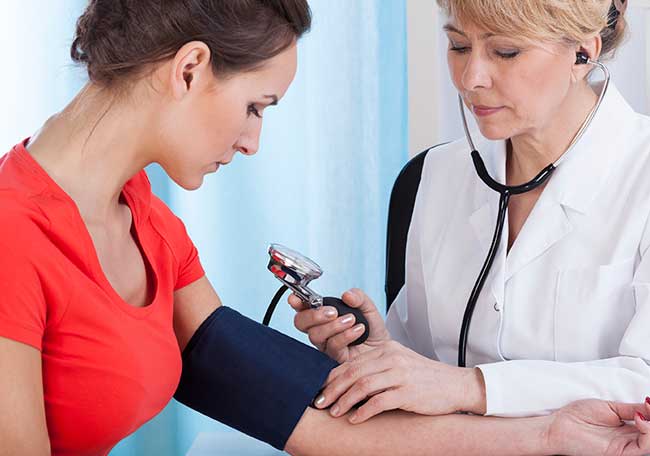Microangiopatía trombótica

1. Moake JL. Thrombotic microangiopathies. N Engl J Med 2002; 347:589-600.
2. Laszik ZG, Silva FG. Hemolytic uremic syndrome, thrombotic thrombocytopenia purpura, and other thrombotic microangiopathies and coagulopathies. In: Jennett JC, Olson JL, Schwartz MM, Silva FG, eds. Heptinstall’s pathology of the kidney. 6th ed. Philadelphia: Lippincott Williams & Wilkins, 2007:699-762.
3. Jennette JC, Falk RJ, Bacon PA, et al. 2012 Revised international Chapel Hill consensus conference nomenclature of vasculitides. Arthritis Rheum 2013; 65:1-11.
4. Moschcowitz E. Hyaline thrombosis of the terminal arterioles and capillaries: a hitherto undescribed disease. Proc NY Pathol Soc 1924; 24:21-4.
5. Moake JL, Rudy CK, Troll JH, et al. Unusually large plasma factor VIII: von Willebrand factor multimers in chronic relapsing thrombotic thrombocytopenic purpura. N Engl J Med 1982; 307:1432-5.
6. Furlan M, Robles R, Limmle B. Partial purification and characterization of a protease from human plasma cleaving von Willebrand factor to fragments produced by in vivo proteolysis. Blood 1996; 87:4223-34.
7. Tsai H-M. Physiologic cleavage of von Willebrand factor by a plasma protease is dependent on its conformation and requires calcium ion. Blood 1996; 87:4235-44.
8. Levy GG, Nichols WC, Lian EC, et al. Mutations in a member of the ADAMTS gene family cause thrombotic thrombocytopenic purpura. Nature 2001; 413:488-94.
9. Fujimura Y, Matsumoto M, Isonishi A, et al. Natural history of Upshaw-Schulman syndrome based on ADAMTS13 gene analysis in Japan. J Thromb Haemost 2011; 9: Suppl 1:283-301.
10. Reese JA, Muthurajah DS, Kremer Hovinga JA, Vesely SK, Terrell DR, George JN. Children and adults with thrombotic thrombocytopenic purpura associated with severe, acquired Adamts13 deficiency: comparison of incidence, demographic and clinical features. Pediatr Blood Cancer 2013; 60:1676-82.
11. Fuchs WE, George JN, Dotin LN, Sears DA. Thrombotic thrombocytopenic purpura: occurrence two years apart during late pregnancy in two sisters. JAMA 1976; 235:2126 7.
12. Moatti-Cohen M, Garrec C, Wolf M, et al. Unexpected frequency of Upshaw-Schulman syndrome in pregnancy-onset thrombotic thrombocytopenic purpura. Blood 2012; 119:5888-97.
13. Lotta LA, Wu HM, Mackie IJ, et al. Residual plasmatic activity of ADAMTS13 is correlated with phenotype severity in congenital thrombotic thrombocytopenic purport. Blood 2012; 120:440-8.
14. Motto DG, Chauhan AK, Zhu G, et al. Shiga toxin triggers thrombotic thrombocytopenic purpura in genetically susceptible ADAMTS13-deficient mice. J Clin Invest 2005; 115:2752-61.
15. George JN, Chen Q, Deford CC, Al-Nouri ZL. Ten patient stories illustrating the extraordinarily diverse clinical features of patients with thrombotic thrombocytopenic purpura and severe ADAMTS13 deficiency. J Clin Apher 2012; 27:302-11.
16. George JN. How I treat patients with thrombotic thrombocytopenic purpura: 2010. Blood 2010; 116:4060-9. [Erratum, Blood 2011; 117:5551.]
17. Kremer Hovinga JA, Vesely SK, Terrell DR, Limmle B, George JN. Survival and relapse in patients with thrombotic thrombocytopenic purpura. Blood 2010; 115: 1500-11.
18. Froehlich-Zahnd R, George JN, Vesely SK, et al. Evidence for a role of anti-ADAMTS13 autoantibodies despite normal ADAMTS13 activity in recurrent thrombotic thrombocytopenic purpura. Hematological 2012; 97:297-303.
19. Furlan M, Robles R, Morselli B, Sandoz P, L.mmle B. Recovery and half-life of von Willebrand factor-cleaving protease after plasma therapy in patients with thrombotic thrombocytopenic purpura. Thromb Haemost 1999; 81:8-13.
20. Naik S, Mahoney DH. Successful treatment of congenital TTP with a novel approach using plasma-derived factor VIII. J Pediatr Hematol Oncol 2013; 35:551-3.
21. Amorosi EL, Ultmann JE. Thrombotic thrombocytopenic purpura: report of 16 cases and review of the literature. Medicine 1966; 45:139-59.
22. Rock GA, Shumak KH, Buskard NA, et al. Comparison of plasma exchange with plasma infusion in the treatment of thrombotic thrombocytopenic purpura. N Engl J Med 1991; 325:393-7.
23. Gandhi C, Khan MM, Lentz SR, Chauhan AK. ADAMTS13 reduces vascular inflammation and the development of early atherosclerosis in mice. Blood 2012; 119: 2385-91.
24. Kennedy AS, Lewis QF, Scott JG, et al. Cognitive deficits after recovery from thrombotic thrombocytopenic purpura. Transfusion 2009; 49:1092-101.
25. Deford CC, Reese JA, Schwartz LH, et al. Multiple major morbidities and increased mortality during long-term follow-up after recovery from thrombotic thrombocytopenic purpura. Blood 2013; 122:2023-9.
26. Kaplan BS, Chesney RW, Drummond KN. Hemolytic uremic syndrome in families. N Engl J Med 1975; 292:1090-3.
27. Farr MJ, Roberts S, Morley AR, Dewar DF, Uldall PR, Uldall PR. The haemolytic uraemic syndrome — a family study. Q J Med 1975; 44:161-88.
28. Thompson RA, Winterborn MH. Hypocomplementaemia due to a genetic deficiency of beta 1H globulin. Clin Exp Immunol 1981; 46:110-9.
29. Warwicker P, Goodship TH, Donne RL, et al. Genetic studies into inherited and sporadic hemolytic uremic syndrome. Kidney Int 1998; 53:836-44.
30. St.hl A-L, Vaziri-Sani F, Heinen S, et al. Factor H dysfunction in patients with atypical hemolytic uremic syndrome contributes to complement deposition on platelets and their activation. Blood 2008; 111:5307-15.
31. Noris M, Caprioli J, Bresin E, et al. Relative role of genetic complement abnormalities in sporadic and familial aHUS and their impact on clinical phenotype. Clin J Am Soc Nephrol 2010; 5:1844-59.
32. Bu F, Maga T, Meyer NC, et al. Comprehensive genetic analysis of complement and coagulation genes in atypical hemolytic uremic syndrome. J Am Soc Nephrol 2014; 25:55-64.
33. Legendre CM, Licht C, Muus P, et al. Terminal complement inhibitor eculizumab in atypical hemolytic–uremic syndrome. N Engl J Med 2013; 368:2169-81.
34. Loriat C, Fakhouri F, Ariceta G, et al. An international view on the management of atypical hemolytic uremic syndrome. Pediatr Nephrol (in press).
35. Nishimura J-I, Yamamoto M, Hayashi S, et al. Genetic variants in C5 and poor response to eculizumab. N Engl J Med 2014; 370:632-9.
36. Gasser C, Gautier E, Steck A, Siebenmann RE, Oechslin R. H.molytisch-ur.mische Syndrome: bilaterale Nierenrindennekrosen bei akuten erworbenen h.molytischen An.mien. Schweiz Med Wochenschr 1955; 85:905-9.
37. Javett SN, Senior B. Syndrome of hemolysis, thrombopenia and nephropathy in infancy. Pediatrics 1962; 29:209-23.
38. Rahaman MM, JamiulAlam AK, Islam MR, Greenough WBI III. Shiga bacillus dysentery associated with marked leukocytosis and erythrocyte fragmentation. Johns Hopkins Med J 1975; 136:65-70.
39. Riley LW, Remis RS, Helgerson SD,et al. Hemorrhagic colitis associated with a rare Escherichia coli serotype. N Engl J Med 1983; 308:681-5.
40. Karmali MA, Steele BT, Petric M, Lim C. Sporadic cases of haemolytic-uraemic syndrome associated with faecal cytotoxin and cytotoxin-producing Escherichia coli in stools. Lancet 1983; 1:619-20.
41. Tarr PI, Gordon CA, Chandler WL. Shiga-toxin-producing Escherichia coli and haemolytic uraemic syndrome. Lancet 2005; 365:1073-86.
42. Pennington H. Escherichia coli O157. Lancet 2010; 376:1428-35.
43. Wittenberg DF. Emerging and reemerging diseases — epidemic enterohaemorrhagic infections 100 years after Shiga. S Afr Med J 1999; 89:750-2.
44. Bell BP, Goldoft M, Griffin PM, et al. A multistate outbreak of Escherichia coliO157:H7-associated bloody diarrhea and hemolytic uremic syndrome from hamburgers: the Washington experience. JAMA1994; 272:1349-53.
45. Buchholz U, Bernard H, Werber D, et al. German outbreak of Escherichia coliO104:H4 associated with sprouts. N Engl J Med 2011; 365:1763-70.
46. Maki DG. Don’t eat the spinach —controlling food borne infectious disease. N Engl J Med 2006; 355:1952-5.
47. Karpac CA, Li X, Terrell DR, et al. Sporadic bloody diarrhoea-associated thrombotic thrombocytopenic purpura haemolytic uraemic syndrome: an adult and paediatric comparison. Br J Haematol 2008; 141:696-707.
48. Huang J, Motto DG, Bundle DR, Sadler JE. Shiga toxin B subunits induce VWF secretion by human endothelial cells and thrombotic microangiopathy in ADAMTS13-deficient mice. Blood 2010; 116:3653-9.
49. Robinson LA, Hurley RM, Lingwood C, Matsell DG. Escherichia coli verotoxin binding to human paediatric glomerular mesangial cells. Pediatr Nephrol 1995; 9: 700-4.
50. Ergonul Z, Clayton F, Fogo AB, Kohan DE. Shigatoxin-1 binding and receptor expression in human kidneys do not change with age. Pediatr Nephrol 2003; 18:246-53.
51. Hughes AK, Ergonul Z, Stricklett PK, Kohan DE. Molecular basis for high renal cell sensitivity to the cytotoxic effects ofshigatoxin-1: up regulation of globotriaosylceramide expression. J Am Soc Nephrol2002; 13:2239-45.
52. Endo Y, Tsurugi K, Yutsudo T, Takeda Y, Ogasawara T, Igarashi K. Site of action of a Vero toxin (VT2) from Escherichia coli O157:H7 and of Shiga toxin on eukaryotic ribosomes: RNA N-glycosidase activity of the toxins. Eur J Biochem 1988; 171:45-50.
53. Chandler WL, Jelacic S, Boster DR, et al. Prothrombotic coagulation abnormalities preceding the hemolytic–uremic syndrome. N Engl J Med 2002;346:23-32. [Erratum, N Engle J Med 2002; 346:715.]
54. Gag AX, Sure RS, Barrowman N, et al. Long-term renal prognosis of diarrhea associated hemolytic uremic syndrome: a systematic review, meta-analysis, and meta-regression. JAMA 2003; 290:1360-70.
55. Rosales A, Hofer J, Zimmerhackl L-B, et al. Need for long-term follow-up in enterohemorrhagic Escherichia coli-associated hemolytic uremic syndrome due to late emerging sequelae. Clin Infect Dis 2012; 54:1413-21.
56. Edwards IR, Aronson JK. Adverse drug reactions: definitions, diagnosis, and management. Lancet 2000; 356:1255-9.
57. Webb RF, Ramirez AM, Hocken AG, Pettit JE. Acute intravascular haemolysis due to quinine. N Z Med J 1980; 91:14-6.
58. Gottschall JL, Neahring B, McFarland JG, Wu G-G, Weitekamp LA, Aster RH. Quinine-induced immune thrombocytopenia with hemolytic uremic syndrome: clinical and serological findings in nine patients and review of literature. Am J Hematol1994; 47:283-9.
59. Kojouri K, Vesely SK, George JN. Quinine-associated thrombotic thrombocytopenic purport-hemolytic uremic syndrome: frequency, clinical features, and long-term outcomes. Ann Intern Med 2001; 135:1047-51.
60. Huynh M, Chee K, Lau DHM. Thrombotic thrombocytopenic purpura associated with quetiapine. Ann Pharmacother2005; 39:1346-8.
61. Saif MW, Xyla V, Makrilia N, BliziotisI, Syrigos K. Thrombotic microangiopathy associated with gemcitabine: rare but real. Expert Opin Drug Saf 2009; 8:257-60.
62. Bougie DW, Wilker PR, Aster RH. Patients with quinine-induced immune thrombocytopenia have both “drug-dependent” and “drug-specific” antibodies. Blood 2006; 108:922-7.
63. Glynne P, Salama A, Chaudhry A, Swirsky D, Lightstone L. Quinine-induced immune thrombocytopenic purpura followed by hemolytic uremic syndrome. Am J Kidney Dis 1999; 33:133-7.
64. Sartelet H, Toupance O, Lorenzato M, et al. Sirolimus-induced thrombotic microangiopathy is associated with decreased expression of vascular endothelial growth factor in kidneys. Am J Transplant 2005; 5:2441-7.
65. Eremina V, Jefferson JA, Kowalewska J, et al. VEGF inhibition and renal thrombotic microangiopathy. N Engl J Med 2008; 358:1129-36.
66. Thrombotic thrombocytopenic purpura (TTP)-like illness associated with intravenous Opana ER abuse — Tennessee, 2012. MMWR Morb Mortal Wkly Rep 2013; 62:1-4.
67. Russo P, Doyon J, Sonsino E, Ogier H, Saudubray J-M. A congenital anomaly of vitamin B12 metabolism: a study of three cases. Hum Pathol 1992; 23:504-12.
68. Geraghty MT, Perlman EJ, Martin LS, et al. Cobalamin C defect associated with hemolytic-uremic syndrome. J Pediatr 1992; 120:934-7.
69. Cornec-Le Gall E, Delmas Y, De Parscau L, et al. Adult-onset eculizumab resistant hemolytic uremic syndrome associated with cobalamina C deficiency. Am J Kidney Dies 2014; 63:119-23.
70. Coppola A, Davi G, De Stefano V, Mancini FP, Cerbone AM, Di Minno G. Homocysteine, coagulation, platelet function, and thrombosis. Semen Thrombi He most 2000; 26:243-54.
71. Delvaeye M, Noris M, De Vriese A, et al.Thrombomodulin mutations in atypical hemolytic–uremic syndrome. N Engl J Med 2009; 361:345-57.
72. Ozaltin F, Li B, Rauhauser A, et al. DGKE variants cause a glomerular microangiopathy that mimics membranoproliferative GN. J Am Soc Nephrol 2013; 24:377-84.
73. Lemaire M, Frémeaux-Bacchi V, Schaefer F, et al. Recessive mutations in DGKE cause atypical hemolytic-uremic syndrome. Nat Genet 2013; 45:531-6.
74. Quaggin SE. DGKE and atypical HUS. Nat Genet 2013; 45:475-6.
75. Hosler GA, Cusumano AM, Hutchins GM. Thrombotic thrombocytopenic purpura and hemolytic uremic syndrome are distinct pathologic entities: a review of 56autopsy cases. Arch Pathol Lab Med 2003; 127:834-9.
Comentarios
Para ver los comentarios de sus colegas o para expresar su opinión debe ingresar con su cuenta de IntraMed.









